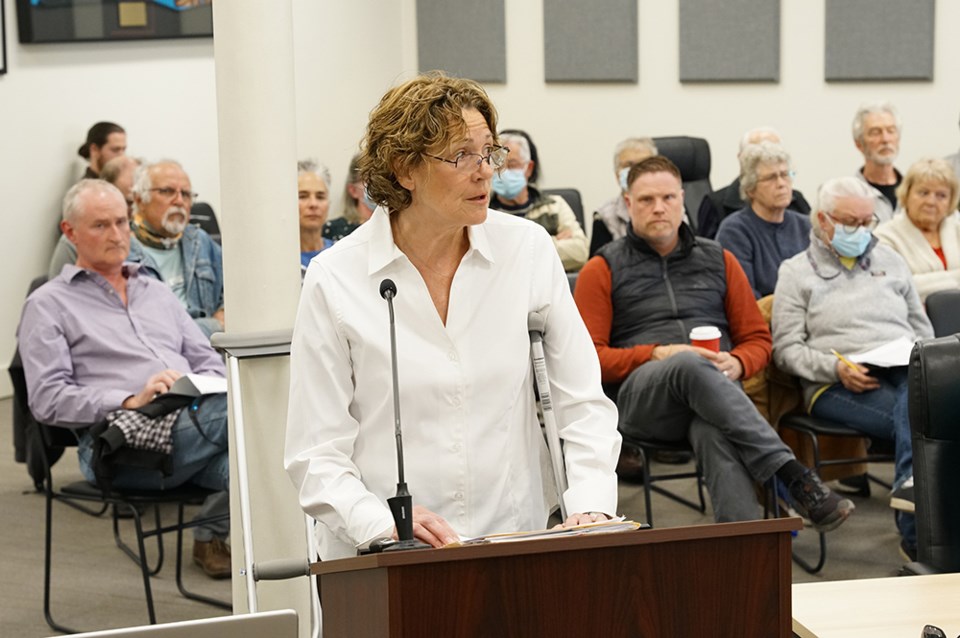City of Powell River’s committee of the whole recently heard concerns about a proposed annexation of property on Nootka Street.
At the May 17 meeting, councillors heard from Nootka-area resident Kathy Pedneault, who gave a detailed presentation on a proposed project by Grasshopper Developments for incorporating properties into city boundaries.
Pedneault, a Nootka resident for 35 years, said the upper street area is a unique rural area adjacent or congruent to the city, comprising 44 properties, plus 22 in a modular home park. She said the area is surrounded by forest with one roadway access in and out.
According to Pedneault, in 1999, area residents came together and passed the Nootka Street zoning bylaw that set the minimum land parcel at one hectare.
“Parcels on record in the land title office prior to the enactment of the bylaw were grandfathered, provided that the residential density did not exceed one dwelling unit per parcel,” said Pedneault. “Residents felt a need to preserve their rural lifestyle, and to ensure the level of development in the area was consistent with available services, including water, sewer and fire protection, and the importance of protecting the area’s aquifer.”
Pedneault said for the proposed Grasshopper development of 240 housing units, the area would see an influx of 624 residents, 120 of whom would be children, and an additional 480 vehicles on the roadway utilizing one-way access.
“Upper Nootka Street is a unique area within the qathet Regional District (qRD) and the greater community, including the city,” said Pedneault. “Development of the 15.7 hectares at 7440 Nootka Street in keeping with its rural setting is possible, and at the same time, it can provide housing needs, just not 240 units. We must not lose this rural lifestyle that many choose, nor our recreational trails or accessibility to these trails.”
Pedneault said the annexation and development plans do not promote infill, but rather, the opposite – urban sprawl.
She said it was her concerns about the large expansion, along with those of other area residents, that led them to speak to the regional district planning committee.
“It was our concerns that led qRD to request city council postpone consideration of any boundary change to annex property until such time as time as a regional growth strategy could be conducted,” said Pedneault. “A regional growth strategy (RGS) will give a voice to all residents within the area that the annexation process does not grant as we are not property owners or residents within the annexation area.
“While an RGS is not a requirement, but is optional during the annexation process, the RGS requested by qRD should not be looked upon as an 11th hour stall tactic, but as an opportunity for engagement with all parties.”
Growth plans
Pedneault said the city’s sustainable official community plan states that it will continue to work with adjacent jurisdictions of qRD and Tla’amin Nation to develop mutually agreed upon criteria for appropriate development along the boundary of the city, and that the city is committed to sharing information and coordinating efforts with qRD and Tla’amin to ensure any growth adjacent to city boundaries occurs in a planned, complementary and sustainable manner.
“A cooperative regional growth strategy would go a long way to fulfilling the city’s policies of interjurisdictional cooperation,” said Pedneault. “I would suggest that even if a regional growth strategy was not undertaken, there should still be extensive traffic studies, harmonized land-use analysis, greenhouse gas emissions study on pre-development levels for the area proposed, as well as proposed post-development carbon dioxide emission levels based on the number of cars a development of this size would add.”
Councillor Cindy Elliott said a regional growth strategy is a good idea because the city should know before annexations come up which areas it is looking toward for community expansion if it’s needed and what criteria would be used to decide that.
Councillor George Doubt asked staff when this development proposal will be coming back for further consideration.
Director of planning services Jason Gow said when a report was presented April 5, it was there to help council decide whether or not to direct staff to prepare the proposal for the province.
“From staff’s perspective, we’ve done our work and delivered a report; we are awaiting direction from you,” said Gow. “Staff are intending to return with a report that relates to amending the fee bylaw so that in future, there would be an ability for us to charge a fee for something that is not in keeping with our general application process.”
Gow said it is in council’s authority to decide as to whether or not they want to give direction to staff to prepare the annexation proposal.



